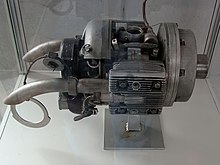BMW 003
The BMW 003 is a single-shaft jet engine from the German manufacturer BMW . It was the first jet engine ever to be equipped with an annular combustion chamber and had internally cooled turbine blades . Both the seven-stage compressor and the single-stage turbine were of an axial design. The nozzle was adjustable. To start the engine at the served Victoria built in Nürnberg " Riedel -Anlasser", a two-cylinder two-stroke - boxer engine with extremely short stroke (270 cm 3 capacity and 10.5 bhp at 7150 min -1 ) of an electrically or with Pull starter has started.
development
The complicated, but performance-enhancing design repeatedly led to delays in the program. In 1939 the project with the RLM number 109-003 was started under the direction of Hermann Oestrich at Brandenburgische Motorenwerke GmbH (Bramo) in Berlin-Spandau . The internal designation was P3302. In the same year, BMW took over the company and continued development at BMW-Flugmotorenwerke Brandenburg GmbH . Research and development remained in Spandau and the Basdorf branch in Brandenburg. A parallel development with a compressor running in the opposite direction to the turbine (RLM 109-002) has been discontinued.
Initially ten test engines with the designation P3302 V1 – V10, which had a six-stage compressor, were launched. The first engine was already running at the end of 1940, but initially developed significantly less thrust than calculated; instead of the projected 600 kp , around 5.8 kN , it was only around 250 kp. But the specific fuel consumption was also too high and the turbine blades were often broken. Fundamental problems led to an extensive redesign.
A new test series of six engines with the designation P3302 V11-V16 was launched, which were larger and had a seven-stage compressor. These engines initially generated a thrust of 450 kp; from the beginning of 1942 it was 550 kp.
testing
Flight tests began in mid-1941 with a converted Bf 110 . The first use of the engine on a prototype of the Me 262 in March 1942 almost ended in disaster because one of the engines failed in flight and the other had to be shut down for safety. The Me 262 was then redesigned for the Junkers Jumo 004 .
The engine, which was given the RLM designation BMW 003, was fundamentally redesigned . It was possible to eliminate problems with vibration fractures in the first compressor stage and to significantly improve the cooling of the hollow turbine blades. In mid-1943, the first ten series engines with the series identification BMW 003 A-0 were commissioned by the RLM. In test runs , thrusts of 800 kp were regularly achieved. In October 1943, flight tests began with an engine mounted under a Ju 88 , which was also successful. Endurance runs of 50 hours at full load were regularly achieved in December. As a result, the number of pieces in the A-0 series was increased to 100 pieces.
Series production and use
From August 1944, the engine with the designation BMW 003 A-1, which corresponded to the A-0 standard, was produced in series. The output was about 100 engines per month. Both the Heinkel He 162 and the Arado Ar 234 were equipped with this 800 kp thrust engine as standard, since there were not enough more powerful Jumo 004 engines available.
Other variants
BMW 003 A-2
Engine based on the A-1, but in an optimized design so that as little fuel as possible has to be used. The performance remained the same and it was transferred to series production.
BMW 003 C.
Engine with modified, also seven-stage compressor from the BBC . The static thrust increased to 900 kp, but there were only test engines.
BMW 003 D
Variant under development with two-stage turbine and eight-stage compressor. Projected static thrust 1100 kp. The engine was not executed.
BMW 003 E-1
Execution like A-1, but with modified suspension for He 162.
BMW 003 E-2
Execution like A-2, but with modified suspension for He 162. The engine could be overloaded to 923 kp thrust for 30 seconds. Series engine He-162 A2.
BMW 003 R.
A variant of the BMW 003A was combined with a small rocket motor that was able to deliver an additional 1000 kp of thrust for a short time. This combination engine, which was tested on both the Me 262 and the He 162, was named BMW 003R.
Ishikawajima Ne-20
In 1944, license negotiations for the production of the BMW 003 in Japan at the Ishikawajima company were successfully concluded. Due to the war situation, however, only blueprints and photos got to Japan. The Japanese Ishikawajima Ne-20 was constructed on this basis . However, the Japanese replica delivered a maximum thrust of only 4.6 kN compared to the 7.8 kN of the BMW 003.
RD-20 and RD-21
In the Soviet Union, after the Second World War, it continued to be produced as the RD-20 for a while and was used in series on the MiG-9 . A variant with higher power through afterburner was called the RD-21 or RD-20F.
Further developments
A total of around 750 of these engines were built during the war, but most of them were no longer used. The engine was produced in Basdorf and in the Mittelwerke .
The development manager Oestrich initially fled to Austria, but then received an offer from Voisin , which belonged to SNECMA . There he developed the SNECMA Atar engine.
Technical data BMW 003 A-1
- Length: 3.53 m
- Diameter: 690 mm
- Weight: 562 kg
- Thrust: 7.8 kN
- Maximum speed: 9500 min −1
- Specific consumption: 1.31 kg / kp / h
Web links
- BMW 003. In: BMW History. BMW AG, accessed on January 23, 2016 (dossier of the BMW Group archive).
Individual evidence
- ↑ Dr. Hermann Oestrich. In: BMW history. BMW AG, accessed on January 23, 2016 (dossier of the BMW Group archive).





